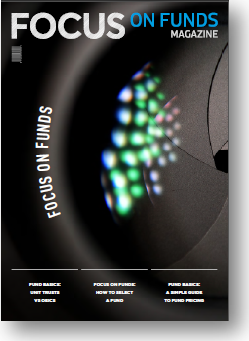May
2022
Focus on Funds: Success factors for Multi-Asset selection
DIY Investor
31 May 2022

Square Mile is an independent investment research business that works in partnership with regulated professional financial services firms. They help advisers and institutions to develop informed investment solutions so that, with their support, their clients can make the decisions that are right for them.
Focusing first and foremost on in depth, qualitative fund research, they provide tailored support and investment services for financial advisers, institutions and asset managers.
This article describes the key criteria that Square Mile uses to analyse and monitor funds in order to help you select a mutual fund that meets your investing goal and risk appetite.
The demand for multi-asset funds and solutions has led to strong growth across the sector over recent years. For example, the IA Mixed Investment sectors have grown from circa £40bn in 2010 to £145bn in 2018, in excess of a 300% increase in a little over eight years.
We see little reason for the popularity of multi-asset funds and solutions to dissipate any time soon. The structural drivers supporting their use by advisers and investors seem firmly set. We think the sector is set to continue to grow, but we also think the pressure on costs is likely to remain.
Characteristics of successful strategies
Square Mile look for a number of key characteristics when analysing multi-asset funds. We have a preference for the following attributes when selecting multi-asset funds and strategies as we believe these attributes are most likely to drive success in the future.
These factors also support advisers in their job of recommending the right fund to the right client and ensuring a fund is:
- Meeting a client’s suitability requirements
- Meeting a client’s investment objectives
- Monitored for ongoing suitability and delivery of objectives.
Meeting a clients’ suitability requirements
Advisers can only make suitable recommendations if funds are clear about their performance and risk objectives and how they meet those objectives. At the same time, these funds need to offer good value for money.
Clear outcome
At the outset, there needs to be a clear articulation of what outcome an investor can expect from their investment. This could be capital accumulation, income, inflation protection, capital protection or a combination of these.
Clear and measurable performance or risk objective
A clear, measurable performance or risk objective will give a helpful expectation of what investors can expect from a fund. This objective sets the framework for the management of the fund and the level of risk that needs to be taken to meet the objective.
Articulation of an expected risk profile
This is essential if an investor or adviser is to make a judgement on the suitability of the investment.
Advisers retain responsibility for suitability even if they have “outsourced” investment management. Risk measurement should include a range of measures including a focus on capital drawdown which aligns better than volatility with a client’s understanding of risk and their capacity for loss. Funds that can provide investors with clarity around the level of risk they are likely to take are desirable to advisers in their need to demonstrate ongoing suitability
Value for money
We accept that active management is more expensive than passively implemented strategies. However, fees are the only known in investing and their compound effect on returns should not be underestimated. “Value for money” does not preclude higher-cost offerings, but they must demonstrate superior risk-adjusted returns. Cost transparency is essential to determine value for money which limits the appeal of traditional and new breed with-profits funds and of some DFM offerings.
Investment Capability to Meet Objective
In short, are there enough resources to meet the fund’s ambitions? Do they have enough people to research a range of asset classes successfully? Is this approach diligent and repeatable?
Parent company commitment to multi-asset investing
Where a parent group is committed to multi-asset investing, it is more likely to invest in appropriate resources to support success. This will include recruiting talented investment professionals and investing in the necessary technology and infrastructure to deliver operational and trading efficiencies.
Strong team-based investment process
A strong team-based process, ideally not centred around one star manager, serves investors’ interests best. Given the totality of the investable universe for multi-asset funds, breadth of knowledge and expertise is required to demonstrate the appropriate skill-set to execute these strategies successfully.
Well defined and articulated investment process
A good and well-defined investment process helps to deliver continuity of approach and anticipated outcome.
Strong risk controls
The investment process should have clear risk controls to ensure that managers do not exceed the remit of their mandate and expose investors to unintended and unexpected risk. Companies with strong risk management processes are preferred.
Flexibility
Within the scope of the fund’s mandate, objective and investment approach, funds with flexibility and a wide tool kit have the potential to deliver more consistent returns through time.
Does the fund remain suitable and is it meeting objectives?
Funds are not static, and multi-asset funds need to be tested against their stated objectives to ensure they remain suitable for clients.
Good risk-adjusted performance
Ultimately, good risk adjusted performance needs to be delivered in line with initial investor expectations. Many multi-asset funds that were launched after the financial crisis in 2008 have arguably yet to be fully tested, and often have track records of less than five years.
Transparent investor communication
Reporting portfolio activity, positioning and performance transparently helps with ongoing due diligence, helping advisers and their investors to fully understand the fund they are using. This helps investors understand performance, particularly in relation to short-term performance issues that are explainable and reasonable in the context of the fund’s strategy.

EQi is a DIY investing platform designed for individuals. It gives you access to global markets, control over your investments and offers customers award-winning support.
Find out more about EQi
EQi has partnered with Square Mile Research, independent experts in researching funds and assessing whether they are meeting their objectives to help the DIY investor select a mutual fund that meets your investing goal and risk appetite.
Our aim is to make it easier and quicker for you to select a mutual fund that suits you; see the Mutual Funds Select List here:
Focus on Funds Magazine: Passionate about active investment management
Click the image to view issue 1
Important Information
This article is for the use of professional advisers and other regulated firms only. It is published by, and remains the copyright of, Square Mile Investment Consulting and Research Ltd (“SM”). SM makes no warranties or representations regarding the accuracy or completeness of the information contained herein. This information represents the views and forecasts of SM at the date of issue but may be subject to change without reference or notification to you. SM does not offer investment advice or make recommendations regarding investments and nothing in this presentation shall be deemed to constitute
financial or investment advice in any way and shall not constitute a regulated activity for the purposes of the Financial Services and Markets Act 2000. This presentation shall not constitute or be deemed to constitute an invitation or inducement to any person to engage in investment activity. Should you undertake any investment activity based on information contained herein, you do so entirely at your own risk and SM shall have no liability whatsoever for any loss, damage, costs or expenses incurred or suffered by you as a result. SM does not accept any responsibility for errors, inaccuracies, omissions or any inconsistencies herein. Past performance is not a guide to future returns.

Leave a Reply
You must be logged in to post a comment.